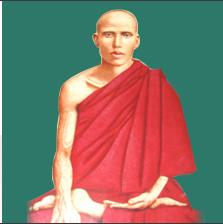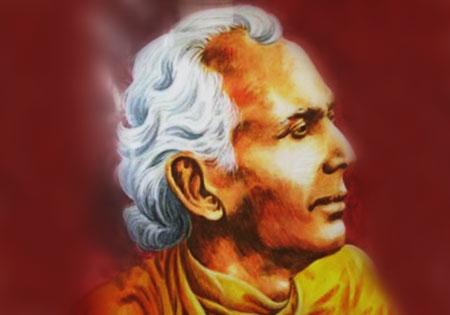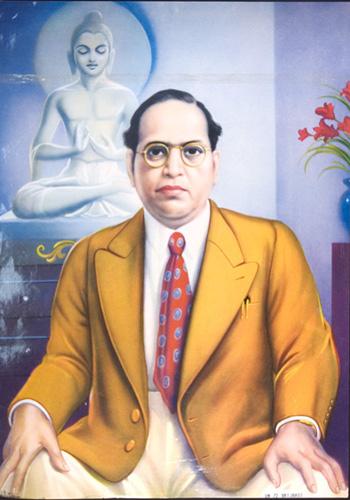
Introduction
A keen observation on Buddhism in the region of Indo-Bangla shows a pendulous motion. Buddhism originated in this territory in the 6th century BCE and it quickly grew due to a multiplicity of reasons. However, after lasting over a thousand years in the land of its origin, Buddhism gradually lost its prominent position. Many scholars have devoted themselves to unraveling this mystery, but due to a lack of consensus over theoretical positions, differences in historical research and understanding of the background, no consolidated research has been done till now. However, by presenting several probable reasons, some scholars have concluded that Buddhism declined in the 13th century CE. Although declining in popularity, Buddhism has continued to survive in several parts of India, such as in the regions of northeast India and the southeastern part of Bengal, especially the Chittagong division which is in present day Bangladesh.
A scholastic survey
Modern scholars like T. Vijayendra in his article Buddhism in Modern India (2006), theorized that Buddhism died in India around the 8th century and Sigrid Harris in his article The rise and decline of Buddhism in India (2008) asserted that by the thirteenth century C.E. Buddhism had disappeared from its native land altogether. However, when we look at Buddhism in Medieval India, we would find Buddhists were not completely uprooted from India. For example, Arthur Waley shows that:

Buddhism survived till the fourteenth century not only in Bengal, Orissa, and Bihar but also in other parts of India including K?ñc?pura (Tamil Nadu), Cola kingdom (Coromandal Coast), Dv?r?vati (Gujarat), and J?la?dhara (Punjab). – New Light on Buddhism in Medieval India (1932, p. 335)
Again, G.E. Harvey observes:
In 17th century C.E., many Buddhists joined the army and the police in the British government, even Buddhists were the majority in the police department of Chittagong. – History of Burma (1925, p. 281)
Moreover, although a great contribution to the revival of Buddhism in India was made by the people of Eastern Bengal, Indian scholars have not recognized this in their studies. For example, T. Vijayendra in his article Buddhism in Modern India (2006) and Vinay Lal in his article Buddhism’s Revival in India in the 20th Century (2006) did not pay attention to the contribution made to the revival of Buddhism in India by the eminent people of Bengal, such as Venerable Kripasaran. They only paid attention to some great people, for instance Anagarika Dhammapala, Babasaheb Ambedkar and so on.
Again, it is worth mentioning that Indian writers mostly highlighted the remarkable contribution of Anagarika Dhammapala to the revival of Buddhism in India before Ambedkar’s conversion to Buddhism in 1956.

Admittedly, Ambedkar’s conversion to Buddhism and Anagarika Dhammapala’s contributions are the most significant developments in the revival of Buddhism in India. However, as Buddhism also survived in Eastern Bengal where a number of people contributed to the revival of Buddhism in the period of Anagarika Dhammapala, it is essential to mark this in the development of the history of Indian Buddhism in the 20th century.
Continued existence of Buddhism in Bengal
Although Buddhism disappeared from several parts of India, it continued to survive in the southeastern part of Bengal in present day Chittagong. Due to the protection of the Arakanese government Buddhists were not uprooted from the Chittagong area. But during the Muslim period they had to struggle hard for their existence. In the meantime, the East Indian Company arrived and due to their sovereign power the British settled down in India and on account of their liberal religious policy, again Buddhism started to develop a solid foundation. In the 19th century, by the initial efforts of some renowned monks and laity, Buddhism occupied an honorable position in Bengal which undoubtedly helped it to revive throughout India. After being awakened by the pioneer works of some western scholars, such as Sir Edwin Arnold and important activities of a number of intellectual people from India and other Asian countries, such as Sri Lanka, Buddhism revitalized its spirit for further development in India.
A great contribution to the revival of Buddhism by Bengalis
It is interesting to study the development of Buddhism in India. In 1864, Venerable Sarmedha Mahathera, the first Sangharaja of the present day Supreme Sangha Council of Bangladesh, came to Chittagong with a number of monks from the Arakhan area of Burma to refine Buddhism in Bengal. At this time, Buddhists of Bengal had been practicing a type of tantricism and superstitious beliefs where Buddhist monks too were not following the rules and regulations according to the Vinaya.
With the support of Queen Kalindi of Rangamati, Venerable Sarmedha rigorously traveled around with some local monks who received higher ordination from him. Venerable Purnachar Mahathera, the second Sangharaja of Bangladesh, and other newly ordained monks divided into two groups and went to Burma and Sri Lanka to learn Buddhism. After coming back home, they supervised and established the Therav?da Buddhist tradition.
Venerable Kripasaran, a great monk from Chittagong, came to Calcutta with an immense hope of serving the Buddhists in that area. He established the Bengal Buddhist Association in 1892, a contemporary of Mahabodhi Society of India. In 1900, he established the Dharmankur Vihar and worked tirelessly for the revival of Buddhism in India. Subsequently, he established Buddhist temples at Simla (Himachal Pradesh) in 1907, Lucknow (Uttar Pradesh) in 1907, Dibrugharh (Assam) in 1908, Shillong (Meghalaya) in 1908, Ranchi (Jharkhand) in 1915, Darjeeling (West Bengal) in 1919, Jamshedpur (Jharkhand) in 1922, all located in present day India.
Although Venerable Kripasaran was engaged with the revival of Buddhism, he contributed to develop P?li language and Buddhist studies. Sir Ashutosh Mookerjee, the Chancellor of Calcutta University, always supported Kripasaran and helped in his activities. With the help of Ashutosh Mookerjee, Venerable Kripasaran was able to affiliate with many schools and colleges in Chittagong where he introduced P?li studies. At Kripasaran’s insistence, higher studies in P?li were introduced at the University of Calcutta by Sir Ashutosh Mookerjee. He also recommended to the Indian government the introduction of scholarships for higher studies in P?li and Buddhist studies at the University of London.
Venerable Kripasaran selected Benimadhab Barua to study at the University of London with scholarships in 1914. In 1917, Benimadhab Barua was the first Asian to be awarded the D.Litt. degree from the University of London, and later served as a professor at the Department of Pali in Calcutta University. Moreover, Venerable Kripasaran also founded a library in 1909 and established the Kripasaran Free Institution in 1912. He started to publish a journal, Jagajjyoti, in 1908, which has been publishing until today receiving wide praise from writers and readers.
Buddhists in Chittagong played an important role in propagating Buddhism in which many social workers and religious people contributed. As a result of their contributions, the Chittagong Buddhist Association was established in 1887, which is now known as the Bangladesh Buddhist Association. In addition, many Buddhist monks and social workers have also contributed to the propagation of Buddhism in Bengal which undoubtedly helped to revive Buddhism throughout India and Bangladesh.
Anagarika Dhammapala in Calcutta
Anagarika Dhammapala, the founder of the Mahabodhi Society of India who was a contemporary of Venerable Kripasaran, came to India from Sri Lanka. After coming to India, he established the Mahabodhi Society of India at Buddhagaya in 1891,for the revival of Buddhism in India. Later, the headquarters of the society was shifted to Calcutta from Buddhagaya and for a considerable period when the Mahabodhi Society of India did not have its own Vihara, all programs were held jointly in cooperation with the Bengal Buddhist Association. Venerable Kripasaranand Dhammapala visited Buddhist sites and worked together with others to develop Buddhism in Calcutta as well as other places. Later, Anagarika Dhammapala visited Chittagong at the invitation of Venerable Kripasaran and observed Buddhist activities in that area.
In conclusion, it is worth mentioning that the fruits of the hard work and sacrificesof Anagarika Dhammapala and Venerable Kripasaran, resulted in the revival of Buddhism throughout India. This continued with the conversion of Dr. Babasaheb Ambedkar to Buddhism with half a million Dalits, formerly known as Untouchables in India, in 1956. Due to political exclusion, when India was partitioned, the talented social and religious people of present day Bangladesh worked together so that Buddhism emerged with a national and international identity. On the other hand, after partition, India remains a multi-religious culture, where Buddhism has begun to rediscover its legacy.
Today several aspects of Buddhism are developing in India such as traditionally, intellectually, literally and socio-politically. For this reason, research on the revival of Buddhism has been conducted from a dizzying pace of perspective and needs to deliver a new approach in which ample important evidence is made available to glorify the consequences of the revival movement in contemporary India and Bangladesh.
References
1. Bapat P. V., ed. (1997). 2500 years of Buddhism. New Delhi: Publication Division, Ministry of I & B,.
2. Chaudhury, Sukomal, (1982). Contemporary Buddhism in Bangladesh. Calcutta: Atish Memorial Publishing Society.
3. Harris, Sigrid. (2008). Article – The rise and decline of Buddhism in India. Thoughts and dreams, WordPress.com, India
4. Jagajjyoti. Kolkata: Journal of the Bengal Buddhist Association.
5. Lal, Vinay. (2006). Article – Buddhism’s Revival in India in the 20th Century. Tamil Nadu, India.
6. Nayyar, Sanjeev, (2003). Article – Why Buddhism vanish from India. Esamskriti & Surya Consulting, India.
7. Vijayendra, T. (2006). Article – Buddhism in Modern India. Kolkata: Frontier.
8. Singh, Shib Deb (1991). Revival and Development of Buddhism in India. Maha Bodhi Society Centenary Celebrations. Vol. 2 Buddhagaya Centre, India.
9. Waley, Arthur. (1932). New Light on Buddhism in Medieval India. Mèlanges chinois et boudhiques






